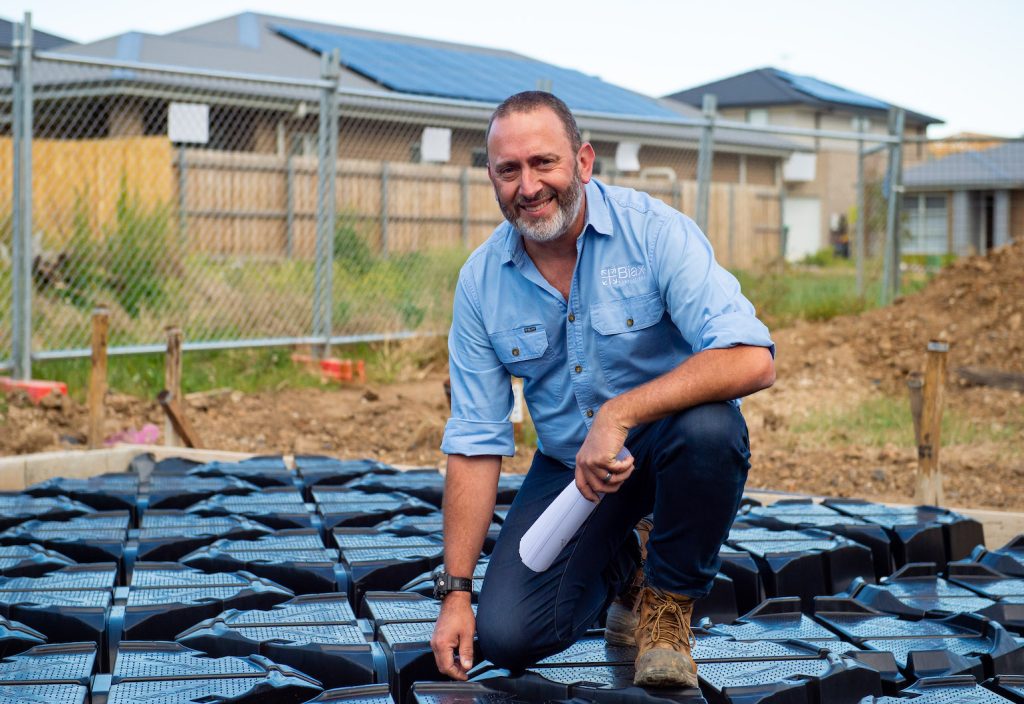An innovative new product could change Australian construction — if the challenges in bringing it to market can be addressed.
It took Jim Prior years to find it. Searching for a sustainable alternative to polystyrene waffle pods in slab foundations, Prior saw a lot of potential products.
But it wasn’t until he found a black box called Biax that Prior thought he had something that fit the bill.
“A lot of those [other] solutions that have existed have typically missed the brief on either buildability, engineering compliance, Australian-standard compliance, cost, usability on site or even environmental,” he says.
“This product ticked all those boxes.”
Prior, now the general manager of Biax Foundations and Chief Operating Officer of Holloway Group, is calling it the next generation of waffle slab.
“This product is a highly sustainable, structurally sound alternative to the current existing solution,” he says.
Prior says Biax is stronger, stiffer and easier to install than the polystyrene used in almost 80 per cent of Australian house foundations. It’s more sustainable, thanks to its construction from recycled plastic. And the stacked product takes up about one seventh of the space, reducing carbon emissions associated with transport.
Biax was invented by Italian structural engineer Fabio Parodi, initially for commercial applications. Prior brought the product to Australia, doing a couple of years of further research and development to get it ready for the local market.
What appears at first glance to be a simple black box hides a host of design considerations. For instance, the pods have tapered sides so they stack. Prior says the taper also changes the shape of the concrete ribs from rectangular to slightly triangular.
“That aids in the stiffness of the slab in terms of structural performance,” he says.
Prior says typical waffle pods in Australia have ribs spaced 1200 mm apart. In Biax, the distance is 750 mm — a measurement originally designed to comply with a New Zealand standard relating to seismic activity.
Grip nodules on the top of the pods stop builders slipping in wet weather or frost. A cross on top and a cone in the centre make the pods easier to work with on site. The pods have a 50 mm rim at the base with holes at the corners so they can be joined with a connector.
“The bottom flange helps get our spacing accurate, which is part of the ability for us to be very accurate with our materials, such as concrete volume,” Prior says.
“Whereas foam pods can drift apart and move under construction … these get locked together. [It’s] all very deliberate in terms of design.”
While the plastic pods are more expensive than their polystyrene equivalent, Prior says the cost is comparable when considering the system as a whole. That’s because Biax is quicker to install, easier to transport and provides opportunities to use less concrete and lower grades of steel reinforcement.
Prior says the extra engineering was key to making the product cost-effective.
“Because plastic is more expensive than foam, the one-for-one replacement doesn’t work financially at all,” he says.
“We’ve got plenty of competitors trying to do it and proving that it doesn’t work.”
In October, Biax was recognised at the 2022 Australian Financial Review Boss Most Innovative Companies Awards, taking out 10th spot in the property, construction and transport category.
Biax says broad adoption of the product could help the building industry eliminate 25,000 t of polystyrene from the building market each year — a lot for a lightweight material.
Despite the benefits, Prior is realistic about the challenges of replacing an incumbent product. “A lot of builders don’t want to be the pioneers,” he says.
“So we keep searching for those who are prepared to go out on a limb a little bit … and then hope that others copy. And that’s starting to happen.”
Prior believes there will be a tipping point when builders get on board.
“There will be a point soon, I think, where people will switch over just by virtue of the number of others using it,” he says. “We’ve seen that happen with many other building products, including the incumbent waffle pod. When that came out 20 to 30 years ago, it took ages for enough people to be using it and for the rest of the industry to go, ‘Right, we’re in.’”
Intrax residential engineer Tomi Oladele says Intrax collaborated with Biax to extensively research the product before deciding to recommend it to residential building clients. For him, the use of recycled materials rather than polystyrene is a big selling point. “Essentially, it can be used for everything that we typically would use a standard waffle setup for,” he says.
Oladele also says it’s simple to apply, particularly for highly reactive sites.
“The main benefit of Biax over the typical system is that it’s quite customisable in terms of the reinforcement and the specifications for it,” he says.
“By comparison, the conventional systems are more standardised, conservative and max-out in highly reactive soils. Biax is quite good because it is a purpose-built slab option with design software. That also keeps things quite straightforward in terms of what can be designed and specced up.”
Oladele points to engineers’ role in meeting their ethical responsibilities to provide sustainable solutions and reduce carbon emissions.
“We need a collective effort from all stakeholders to make sure that we can deal with these climate issues, in terms of the manufacturing, the suppliers and also the building stakeholders,” he says.
Prior hopes to get more people on board every day with an education process around the product. “Once they’re past that, as a user or as a specifier, they’re pretty much on board,” he says.
